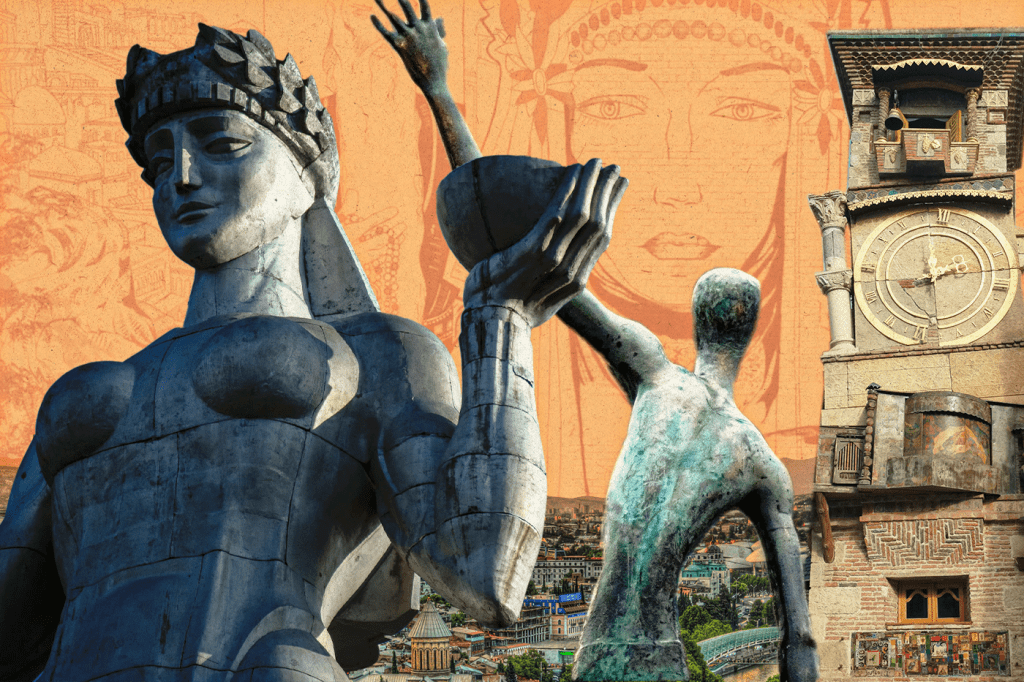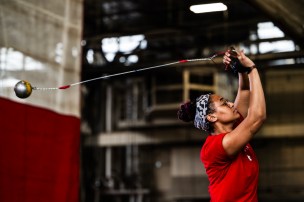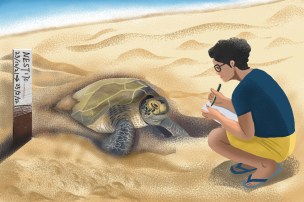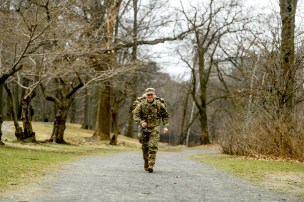Published on
Old architecture, new democracy? In Tbilisi, they go together.
Two married art and architecture professors and their Northeastern students explored an ancient city in the throes of transformation — by a young government, urban renewal and Russian expats fleeing the effects of war.

It’s early evening in July, and Sarah Kanouse is putting her feet up in Fabrika, a hostel and arts space on Tbilisi, Georgia’s Left Bank that was once a Soviet-era sewing factory. But the hostel’s common area, where the Northeastern University art and design professor has claimed a corner to chat, is abuzz with activity.
Huddled together on a blue sectional, Kanouse and a small group of students pass around a pair of AirPods, to be better heard on our Zoom call over the din of multilingual chatter around them. Much of it is in Russian. Since the war in Ukraine broke out, expat Russians have flooded the former Soviet territory’s capital city — fleeing the draft and economic sanctions, driving up housing costs and sparking debate. “You hear a lot of action on the street, you see a lot about the war and about the Russian presence in Georgia playing out in graffiti all over the city,” Kanouse says. “So it’s a very hot topic.”
Kanouse and her students, along with Northeastern architecture professor (and Kanouse’s husband) Nicholas Brown, are one week into a Dialogue of Civilizations study trip in Tbilisi with the theme of “Design for Democracy and Justice.” Today has been relatively quiet: guest lectures about international development and the European Union, followed by gelato and discussion in Tbilisi’s historic Rustaveli Square. The week before was action-packed, with hikes among the region’s ancient villages and mountain ranges amid a muggy heat wave; a picnic of traditional Georgian barbecue — the meat is cooked over grape vines instead of charcoal — and meetups with Georgian professors, activists, urban planners and architecture students.
We’ve described the dialogue as art and architecture focused, but really it is sort of everything. There’s a heavy dose of history, culture and religion.
Nicholas Brown, a professor of architecture at Northeastern
Nestled in a former Soviet bloc between Turkey and Russia, Georgia isn’t the first place that comes to mind as a summer study abroad locale. “It wasn’t on my radar at all,” says Julia Morales, a political science major who graduated in May.
But in terms of both its deep, multilayered past and current political dynamics, there could hardly be a more appropriate setting to study the dialogue’s stated topic. Tbilisi is renowned for its diverse architecture, with medieval city walls and church towers co-mingling with Soviet-era concrete monoliths and vibrant, contemporary street art. And Georgia’s geography and history are hyper relevant to today’s biggest geopolitical conflicts. As in Ukraine, Russia invaded contested regions of the nation in 2008, resulting in a brief war. It’s a new yet relatively robust (not to say uncomplicated) democracy, with regular elections and transfer of political power among ruling parties.
And at the moment, the country is feeling the ripple effects of the war in Ukraine, with Russian expats settling and reshaping the landscape with their presence.
“We’ve described the dialogue as art and architecture focused, but really it is sort of everything,” says Brown. “There’s a heavy dose of history, culture and religion.”
Layering past and present
As an artist, Kanouse works across disciplines, with a focus on the politics of landscape and space. Brown, her husband and frequent collaborator, teaches in the architecture school, examining the relationship between social justice and built environments. The pair first visited Tbilisi in early 2020, while Kanouse was in Munich on a fellowship with the Rachel Carson Foundation. It was just before the COVID-19 pandemic shut down Europe, and Jesse Volger, a friend who ran the architecture school at Tbilisi’s free university, took them on a whirlwind five-day tour.
“He introduced us to so many people and places in a short period of time,” Kanouse recalls. “Our heads were spinning in a very good way. We were immediately thinking about how we might bring Northeastern students.”
Due to COVID, 2023 is the first time Brown and Kanouse have led the trip, and they’ve been thrilled with the student interest and the wealth of opportunities for study on the ground. They’d like to lead it again next summer.
Kanouse was struck by the sheer scope of history in plain sight in Tbilisi’s streets. “I’m really interested in the laminated layers of the past and the present coexisting,” she says. “In cities like Boston, we have some ability to see that. But in a place like Tbilisi, where habitation goes back thousands of years, and where urban transformations in the last 30 years have been extreme and very sudden, you have a fascinating sense of the built environment — both a rapid change and a long duration.”
Arista Neave, a third-year architecture student with an art history minor, says that coexistence of old and new can be credited to the impulse to mix historical preservation with present-day utility. “If there’s a wall, instead of this American tendency to knock it down, Georgians that I’ve met adapt the wall to meet their own needs,” she says. “It’s much more adaptable, and I can imagine not quite as expensive. There’s just this ability to constantly use the obstacle: [they say], I want to start this art collective. Here’s an abandoned museum. I’m going to find the law that says I can use it.”
More than design
Of the nine students on the dialogue, about half study architecture or urban planning. Nicole Roach, a fifth-year architecture major, wants a career designing affordable housing — an issue with a historically different approach in a former communist stronghold. “We’ve been learning a lot about Soviet architecture, and we visited a Soviet-built worker town called Rustavi,” Roach says. “It’s been interesting to see the Soviet lens on affordable housing — Soviet architecture is very rectilinear, with not a lot of ornament. It’s very different from what architects are building in Tbilisi now, and what Americans are building in the United States.”
A highlight for many in the group, though, comes from centuries before. Much of Tblisi’s medieval architecture still stands in the Old Town district, made up of narrow winding hill paths and topped by the fourth-century Narikala fortress. Kanouse was taken with Uplistsikhe, an Iron Age, rock-cut town 14 kilometers west of the city center. “You see the ways that people occupied the site over thousands of years,” she says. “You see, an ancient wine press and ancient pharmacy, sacred spaces, dwelling spaces, and you have the most spectacular views of this entire valley from the top of these rocks.”
Architecture and design aren’t the only things on the agenda. The third week of the trip includes a series of lectures and site visits revolving around the interplay of art, gender and sexuality in Georgia, a majority Orthodox Christian nation. The students will hear from organizers at WISG, a human rights NGO focused on women’s issues. There’s also a syllabus section on ecological design with Alexandra Aroshvili, a noted Georgian researcher and activist.
Then there’s the food. Georgian cuisine is renowned for its singular mix of Middle Eastern and Eastern European flavors; the syllabus even includes debrief sessions at gelati shops and a cooking class at Skijis Sakhli, a bed and breakfast on the outskirts of the city. And don’t sleep on the drinks: in particular, Morales says the lemonade she had during her time in Tbilisi will be hard to forget.
“We went to this one place, and they ordered us a bunch of pizza,” she remembers. “The pizza itself was fine. But it came with lemonades that were tons of different flavors, like mint and strawberry. They were so frothy and thick, like an agua fresca. They make up for the heat by having some incredible drinks.”
Erick Trickey contributed reporting.
Schuyler Velasco is a Northeastern Global News Magazine reporter. Email her at s.velasco@northeastern.edu. Follow her on Twitter @Schuyler_V.





